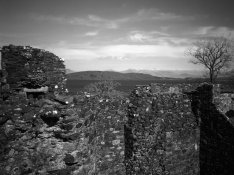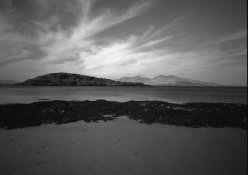destroya
Subscriber
I decided to do a test of the B&W films I normally shoot as well as a few other films I got from a friend and bought at the local store. why, not quite sure but I had some free time and wanted to do some playing. reversal processing is a little like neg processing. each film sorta has its unique developing formula depending on the developer. But me, not being a photographer ( I like it but dont claim to be anything close to resembling a real photographer) and someone who likes science/chemistry/physics thought it wuld be fun to try out. I have done B&W reversal and have two films I usually use, FP4 and ultrafine Xtreme 100. I have a pretty good routine and get very constant results, which I guess is the end goal. so I thought I would try out all my films, use the developing routine I have and see what happens. so I shot using a pentax 645n with the 150A lens and a nikon F3 85mm F2 lens.
FP4 (35mm), ISO 50 to 400
HP5 (120), ISO 240 to 1600
ultrafine Xtreme 100 (120) ISO 25 to 250
ultrafine Xtreme 400 (120) ISO 240 to 1600
Tmax 100 (120) ISO 25 to 250
Tmax 400 (120) ISO 50 to 800
Tri-x 400 (120) ISO 100 to 800
Rollei Retro 80s (35mm) ISO 25 to 200
all films were shot without a filter and then with an orange filter just to see if there would be any difference in END results. End results were a simple viewing of the slides projected, as you would normally view slides.
First observation. When I developed and enlarged/wet printed B&W negs, I never gave a big thought to the base color as it never seemed to make a difference. Not so in PROJECTING them. huge visual difference in the end results. The kodak films all seemed to have a slight olive tint to the base and as such they were the darkest slides when viewing. Next came the Ilford film which was a cooler light grey color. Next the Xtreme films, wich had the lightest grey color and as such had the second best projection result. maybe the lack of an AH layer makes the difference but there was a clear one when projecting. Lastly, or in a major way, first place was the RR80s film. having a truly clear base made all the difference in the world! wow was it awesome to view. I would say that this film gives velvia 50 a run for its money when it comes to projection. just jaw dropping Dmax. and even though it was black and white, there seemed to be so many more shades of grey compared to all the other films. Looks like I found my new B&W slide film.
Next observation: a Filter makes no difference in the brightness of the slide. Maybe its because of an in camera meter, not sure. But the main difference as I expected was in the sky with cloud separation.
Next observation: Tmax 100, like my prior attempt with Pan f+, did not come out at all. Way to dark. My guess is I need a more potent first developer.
Next observation: HP5 had a very wide range of viewable slides. the shots from 320 all the way to 1000, 1200 in a higher contrast scene possbily, would work and I would be happy with the results. Xtreme 400 was very similar in range as well.
Tmax 400 was a workhorse. the shots from 50 to 400 worked and all were acceptable. The greener base had an impact on the slower range, but still in a pinch 400 to 640 would work. an amazing film
Next observation: Price is irrelevant. yes RR80 is the most expensive film but the base makes all the difference. the second best film, for my eye, was the Xtreme 100. Sharp, the lightest base of all the rest of the films, second best shadow detail and a very large exposure range. all the shots from EI 40 to 160 would have been satisfactory, with the sweet spot 100 to 125. The results of this and the 400 ISO film were VERY close to the FP4 and HP5. except for the base, I would say these films could be siblings. if I had to guess, I would say these films are ilford Pan 100 and 400 (but who's asking me).
a long but fun two days. was it worth it, sure. I know know that I' gonna shoot RR80s and Xtreme 100 for my B&W slides. Not sure why I picked those 2 as I would shoot the RR80 at ISO 100 and the Xtreme at 125. But seeing as the Xtreme is $30 a bulk roll and the RR80 $72, it depends if its shooting for fun or shooting for quality. Either way I would be happy with either. I have included a quick snap of the light table with some of the films on it to show the film base colors. and while the picture may show the HP5 having a slightly whiter base, when projected its a little more grey than the Xtreme.
I have nightmare (jokingly) about the demise of E6, so for me I have found a very good substitution for color slides. Its not a hard process and I hope those of you who shoot slides and B&W give it a go.
John

FP4 (35mm), ISO 50 to 400
HP5 (120), ISO 240 to 1600
ultrafine Xtreme 100 (120) ISO 25 to 250
ultrafine Xtreme 400 (120) ISO 240 to 1600
Tmax 100 (120) ISO 25 to 250
Tmax 400 (120) ISO 50 to 800
Tri-x 400 (120) ISO 100 to 800
Rollei Retro 80s (35mm) ISO 25 to 200
all films were shot without a filter and then with an orange filter just to see if there would be any difference in END results. End results were a simple viewing of the slides projected, as you would normally view slides.
First observation. When I developed and enlarged/wet printed B&W negs, I never gave a big thought to the base color as it never seemed to make a difference. Not so in PROJECTING them. huge visual difference in the end results. The kodak films all seemed to have a slight olive tint to the base and as such they were the darkest slides when viewing. Next came the Ilford film which was a cooler light grey color. Next the Xtreme films, wich had the lightest grey color and as such had the second best projection result. maybe the lack of an AH layer makes the difference but there was a clear one when projecting. Lastly, or in a major way, first place was the RR80s film. having a truly clear base made all the difference in the world! wow was it awesome to view. I would say that this film gives velvia 50 a run for its money when it comes to projection. just jaw dropping Dmax. and even though it was black and white, there seemed to be so many more shades of grey compared to all the other films. Looks like I found my new B&W slide film.
Next observation: a Filter makes no difference in the brightness of the slide. Maybe its because of an in camera meter, not sure. But the main difference as I expected was in the sky with cloud separation.
Next observation: Tmax 100, like my prior attempt with Pan f+, did not come out at all. Way to dark. My guess is I need a more potent first developer.
Next observation: HP5 had a very wide range of viewable slides. the shots from 320 all the way to 1000, 1200 in a higher contrast scene possbily, would work and I would be happy with the results. Xtreme 400 was very similar in range as well.
Tmax 400 was a workhorse. the shots from 50 to 400 worked and all were acceptable. The greener base had an impact on the slower range, but still in a pinch 400 to 640 would work. an amazing film
Next observation: Price is irrelevant. yes RR80 is the most expensive film but the base makes all the difference. the second best film, for my eye, was the Xtreme 100. Sharp, the lightest base of all the rest of the films, second best shadow detail and a very large exposure range. all the shots from EI 40 to 160 would have been satisfactory, with the sweet spot 100 to 125. The results of this and the 400 ISO film were VERY close to the FP4 and HP5. except for the base, I would say these films could be siblings. if I had to guess, I would say these films are ilford Pan 100 and 400 (but who's asking me).
a long but fun two days. was it worth it, sure. I know know that I' gonna shoot RR80s and Xtreme 100 for my B&W slides. Not sure why I picked those 2 as I would shoot the RR80 at ISO 100 and the Xtreme at 125. But seeing as the Xtreme is $30 a bulk roll and the RR80 $72, it depends if its shooting for fun or shooting for quality. Either way I would be happy with either. I have included a quick snap of the light table with some of the films on it to show the film base colors. and while the picture may show the HP5 having a slightly whiter base, when projected its a little more grey than the Xtreme.
I have nightmare (jokingly) about the demise of E6, so for me I have found a very good substitution for color slides. Its not a hard process and I hope those of you who shoot slides and B&W give it a go.
John














